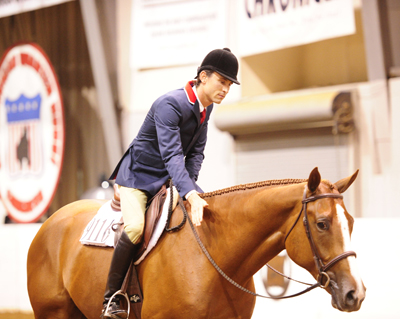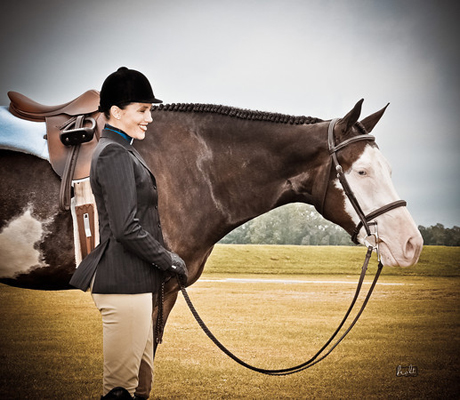 Exhibitors pay upwards of $1,000 for a really good quality custom jacket, but there are many good quality off-the-rack jackets that can be purchased for $250-$500.
Exhibitors pay upwards of $1,000 for a really good quality custom jacket, but there are many good quality off-the-rack jackets that can be purchased for $250-$500.
“I have no problem riding in a top quality jacket that I may have found used for $100. As long as it is current and fits well,” says Alyse Roberts, AQHA and APHA trainer and owner of Alyse Roberts Performance Horses in Yukon, Oklahoma.
Unlike western show tops that go out of style as trends change, hunt coats last for many show seasons. A black coat and a white blouse is a wise investment for any hunter rider.
“I always suggest that the first coat a hunt seat rider buys is black,” says John Hall, owner of The Hitching Post Tack Shop in Middletown, Kentucky.
This traditional, conservative look is suitable for the smallest shows all the way to the World Championships. “It’s just classic. It’s like owning a tuxedo or a good black dress,” says Megan Brown, co-owner of Boo Yah Custom Clothing.
Navy and hunter green are also acceptable. “We notice that some years gray makes a comeback and last year we saw some brown. However, at the big shows, especially in the non-pro classes, black is still the preferred color,” she adds.
Lighter or darker shades within these basic color groups can be used to coordinate with the season or the show location.

Scott Jones
“Riders tend to stick with darker shades for the fall/winter and larger shows like the World Show,” Hodde says, “lighter hues are great for showing outdoors or in less lit arenas.”
Jackets with stripes, plaids or textures add diversity to an otherwise plain color palette. “Contrasting piping really ties in the shirt and also helps tie together with the color of your horse,” she adds.
Jacket collars and lapels are also a good place to add individuality. “A lot of the kids that ride with me have a velvet collar and/or piping on their jackets for a bit of personal expression,” says Scott Jones of Showstring an AQHA and APHA training stable in Boerne, Texas.
The place to add a little color and individuality is in the shirts. “A new shirt can change the whole look of your coat,” Brown says, “using various color shirts for different events, different seasons and depending on if you are showing indoors or outdoors is one way to vary your look.”
Patterned shirts can also add a bit of fashion to the traditionally classic look. “I choose a stripe or plaid for something that’s a bit different and I try not to go too bright,” Jones says.
While you can have a little fun with slight patterns or a colored shirt, remember the classic Hunter Under Saddle look is what is expected in the show pen.
“You should still adhere to the rules of a traditional look, but can veer away and make it your own with piping, trim, velvet and special buttons,” Hodde emphasizes.
 Selecting a hunt coat
Selecting a hunt coat
It’s difficult to assess the quality of the wool by sight. Instead examine the workmanship of the jacket.
“Inspect the seams and stitches. They should be tight,” Hodde says. “Make sure the buttons are securely fastened and the button holes are free of loose ends.”
The jacket lining should be made of silk or a silk blend and should stay in place while putting on and taking the garment off.
“How the lining is finished tells me a lot about the coat,” Roberts says.
Fabric is another feature that distinguishes high-quality coats from lesser quality jackets. “You can feel the difference between high-end fabrics,” Hall says, “like with a man’s or woman’s dress suit, high-end fabrics last longer.”
Light wool blends offer the highest quality and affect the coat’s longevity. “This means the wool will hold its form and be less likely to show wear,” Hodde explains.
Fit is equally important as the fabric. A well-fitted hunt coat creates a sleek, tailored look.
“A properly fitted coat creates the nice long lines you want to see on a hunt seat rider,” Brown says. Numerical sizing in hunt coats is very different from any other piece of clothing you buy. “Our sizes range from 10-18, with a 10 being small, similar to a size 4 in women’s clothes. Don’t be upset if you have to order a size larger than what you usually wear,” she adds.
Sleeve length is important to complete a finished look. “The sleeve should come just past the wrist to the hand so that the glove meets underneath the cuff,” Hall says. This creates a smooth look from the arm to the fingertips. Some riders prefer the edge of their jacket sleeve meet their glove while showing a little cuff from their shirt. “Either is acceptable,” Hodde adds.
 The length of the jacket “tails” contributes to a polished turnout. When you sit in the saddle, the coat should just hit the top of the saddle. “You don’t want to sit on the coat,” Hall explains. On the other hand, it shouldn’t be too short either and not touch the saddle at all.
The length of the jacket “tails” contributes to a polished turnout. When you sit in the saddle, the coat should just hit the top of the saddle. “You don’t want to sit on the coat,” Hall explains. On the other hand, it shouldn’t be too short either and not touch the saddle at all.
How a hunt coat fits the rider’s frame, specifically the shoulders, affects the rider’s overall appearance. “It should sit square with the outside of your bicep,” Hodde explains. If the coat is too loose it will look sloppy and unkempt. “You don’t want the coat to look boxy,” Jones adds.
On the other hand, if it’s too tight across the shoulders the coat will pucker across the rider’s back and shoulders. The cut of the jacket is particularly important for a woman. “For women, the front of the jacket should not be flat. Women need seams, not darts, to allow room for the bust,” Hodde says.
Size Matters
“Sometimes we recommend riders go up a size, but choose a slim fit so that it is tight at the waist and not pulling on the buttons,” Hall says. Fitted does not mean it’s so tight it restricts a rider’s movement. “Hunters tend to need more room because they have to stretch and reach or bend over.
Tall riders in particular may have a difficult time finding an off-the rack jacket that fits properly. “If you are very tall, look for a jacket marked ‘long’,” Roberts suggests. Buying a “long” coat will allow the arms to be long enough and the jacket will rest at the right spot on the rider’s hips. “Nothing looks worse than a jacket that is too short for the person,” she adds.
Though hidden beneath a coat, a shirt can affect the appearance of a coat. Fitted shirts create a smoother profile underneath the coat, while shirts that are too big create a bulky look.
“There’s nothing worse than spending a lot of money on an outfit to have your collar/shirt so big it sags out and ruins the look,” Brown says.
Jacket prices reflect the quality of the wool, the lining, the buttons, the fit and the amount of time it takes to make the jacket. “I tell people there is a price for everything,” Hall says. The more tailored the jacket and the higher the quality of wool, the more expensive the jacket will be. “All of my jackets and shirts are custom and that’s what I recommend to my clients.The quality of fabric and fit is worth the investment,” Jones says.
A well-fitted coat that is high quality is likely to cost anywhere from $400 to $600 or more as customizations are added. On-site show sales often feature jackets on closeout or at reduced prices closer to the $100-$250 range. “For a starter coat or a growing kid, these make sense,” Brown says.
Sale jackets also make great “back-up” options. “I tell clients to save their most expensive coat for the biggest shows and use a less expensive coat if they are going to show in the rain or beating sun,” Hall says.
Gently used jackets can make a great alternative for riders on a budget. “You don’t have to break the bank to look great in a hunter under saddle class, even at the big shows. There are stores now catering to people who are looking for really good quality, gently used show clothes at affordable prices,” Roberts emphasizes.
Proper care is critical to preserving a coat’s longevity. Most high-end jackets, especially those made of wool, are DRY CLEAN ONLY—never throw a hunt coat in the washing machine.
“A friend of ours actually had her dad wash the coat and it came out child size,” Brown says.
It’s inevitable that at a show your horse will drool or slobber on you. Dab it off with a baby wipe and, when you take it to the dry cleaner, point out the stain so they can treat it professionally.
When you find yourself at a long show with multiple days of wearing a coat, Hodde offers a few tips for keeping the jacket fresh and presentable until you can get to the dry cleaners.
“A Tide pen does wonders on spots. Dawn (or other) dish soap takes out grease stains. Mixing it with baking soda can help on the bad ones,” she explains.
Downey Wrinkle Release keeps the jacket smelling fresh and looking nice and a handheld steamer can bring the life back to a jacket after a long day in the hot sun.
At the end of the day, you get what you pay (and care) for.
“A classic hunt coat can last an exhibitor for years, that is the beauty of the sport,” Brown concludes.



You must be logged in to post a comment Login